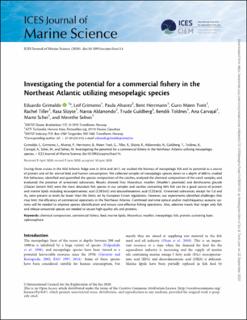Investigating the potential for a commercial fishery in the Northeast Atlantic utilizing mesopelagic species
Grimaldo, Eduardo; Grimsmo, Leif; Álvarez, Paula; Herrmann, Bent; Tveit, Guro Møen; Tiller, Rachel; Slizyte, Rasa; Aldonondo, Naroa; Guldberg, Trude; Toldnes, Bendik; Carvajal, Ana Karina; Schei, Marte; Selnes, Merethe
Peer reviewed, Journal article
Published version
Permanent lenke
https://hdl.handle.net/11250/2685454Utgivelsesdato
2020Metadata
Vis full innførselSamlinger
- Publikasjoner fra CRIStin - SINTEF AS [5801]
- SINTEF Industri [1566]
- SINTEF Ocean [1443]
Sammendrag
During three cruises in the Mid Atlantic Ridge area in 2016 and 2017, we studied the biomass of mesopelagic fish and its potential as a source of protein and oil for animal feed and human consumption. We collected samples of mesopelagic species down to a depth of 600 m, studied fish behaviour, identified and quantified the species composition of the catches, analysed the chemical composition of the catch samples, and evaluated the presence of unwanted substances. Results showed that Maurolicus muelleri (Mueller’s pearlside) and Benthosema glaciale (Glacier lantern fish) were the most abundant fish species in our samples and catches containing 80% fish can be a good source of protein and marine lipids including eicosapentaenoic acid (C20:5n3) and docosahexaenoic acid (C22:6n3). Unwanted substances, except for Cd and As, were present at levels far lower than the limits set by European Union regulations. However, our experiments identified challenges that may limit the efficiency of commercial operations in the Northeast Atlantic. Combined real-time optical and/or multifrequency acoustic systems will be needed to improve species identification and ensure cost-effective fishing operations. Also, selective trawls that target only fish and release unwanted species are needed to secure high-quality oils and proteins.

